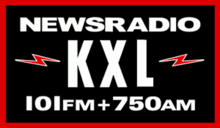KXL-FM
KXL-FM (101.1 MHz FM) is an American commercial radio station broadcasting a news/talk format licensed to Portland, Oregon, United States. The station is currently owned by Alpha Media.[2][3] Its studios are located in downtown Portland, and its transmitter is in Portland's west hills. It is the flagship station for The Lars Larson Show and Ground Zero with Clyde Lewis.
 | |
| City | Portland, Oregon |
|---|---|
| Broadcast area | Portland, Oregon |
| Frequency | 101.1 MHz |
| Branding | FM News 101 KXL |
| Slogan | Portland's breaking news, traffic and weather station: Stay connected |
| Programming | |
| Format | News/Talk |
| Affiliations | CBS Radio News KGW 8 |
| Ownership | |
| Owner | Alpha Media (Alpha Media Licensee LLC) |
| Sister stations | KBFF, KINK, KUFO, KUPL-FM, KXTG |
| History | |
| First air date | September 12, 1948 (as KOIN-FM) |
| Former call signs | KOIN-FM (1948–1977) KYTE-FM (1977–1979) KLLB (1979–1983) KRCK (1983–1985) KYTE-FM (1985–1989) KKCY (1989–1990) KUFO (1990–2001) KUFO-FM (2001–2010) KUFO (2010–2011)[1] |
| Technical information | |
| Facility ID | 26932 |
| Class | C |
| ERP | 100,000 watts |
| HAAT | 502 meters (1,647 ft) |
| Transmitter coordinates | 45°30′57.4″N 122°44′3.4″W |
| Links | |
| Webcast | Listen live |
| Website | www |
History
The station signed on the air as KOIN-FM on September 12, 1948, simulcasting KOIN 970 AM, and began airing classical music in 1967. The four-hour-long KOIN Concert Hall was broadcast weekday evenings from 6 to 10 PM, hosted first by Blaine Hanks, then Don Gay.[4] In May 1977, the station changed their call letters to KYTE-FM and aired a top 40 format as "The FM Kite".[5] On January 5, 1979, KYTE-FM changed their format to country and then changed the call letters to KLLB (as "Country Club 101").[6] On September 4, 1979, KLLB changed format to top 40 rock (as "KB-101 Rock Deluxe"), then changed format to oldies (also as "KB-101") a year later.[4] On November 8, 1982, KLLB switched to an album rock format (as "Rock 101"); in January 1983, the call letters changed to KRCK.[7] On January 3, 1985, KRCK changed their format to classical (as "Classical 101"), and on February 18, 1985, the call letters changed back to KYTE-FM.[6][8] On January 30, 1989, the station changed its call letters to KKCY and aired a contemporary jazz format, branded as "The City". (The classical format was moved to KYTE 970 AM.)[9][10]

On December 29, 1989, at 5 p.m., after a few days of stunting, KKCY changed to an active rock format, and on January 23, 1990, the call letters were changed to KUFO, and on August 1, 2001 to KUFO-FM.[11][1]

In August 2009, CBS Radio sold the Portland cluster (including KUFO) to Alpha Broadcasting in an effort to focus more on major market stations. On October 24, 2009, KUFO began stunting with a "mothership refueling" countdown to end at 7 a.m. on October 28 when it re-launched. The actual musical content of KUFO was the same as it was prior to the re-launch; only the personalities changed.[12] On September 16, 2010, the call sign reverted to simply KUFO.
At 8:47 a.m. on March 15, 2011, KUFO's format was flipped to a simulcast of KXL (750 AM), which broadcasts news and talk shows.[13][14] On March 22, 2011, the station changed its call sign to KXL-FM and billed itself as "News Radio 101 FM & 750 AM KXL" (on the same day, the KUFO call letters would move to 970 AM).[1] It now uses the on air slogan "FM News 101 KXL". This is the second FM station in Portland to use the name KXL-FM; it has been used in the past as the callsign by 101.1's sister station 95.5 (now KBFF).
On May 25, 2011, at 4 p.m., KXL-FM ended its simulcast with KXL (AM), which flipped to sports as KXTG, "750 The Game".[15][16]
On May 6, 2013, KXL-FM announced it had dropped Fox News Radio as an affiliate and picked up CBS Radio News as its preferred news source.[17]
References
- "KXL-FM Call Sign History". United States Federal Communications Commission, audio division. Retrieved March 23, 2011.
- "KXL-FM Facility Record". United States Federal Communications Commission, audio division.
- "KXL-FM Summer 2008 Station Information Profile". Arbitron.
- https://formatchange.com/kufo-relaunches/
- "Alpha turns off KUFO's rock for KXL-FM's news and talk". Portland Tribune. March 15, 2011.
- https://www.facebook.com/101KXL/posts/595574310466481
External links
- FM News 101 KXL on Facebook
- FM News 101 KXL on Twitter
- KXL in the FCC's FM station database
- KXL on Radio-Locator
- KXL in Nielsen Audio's FM station database